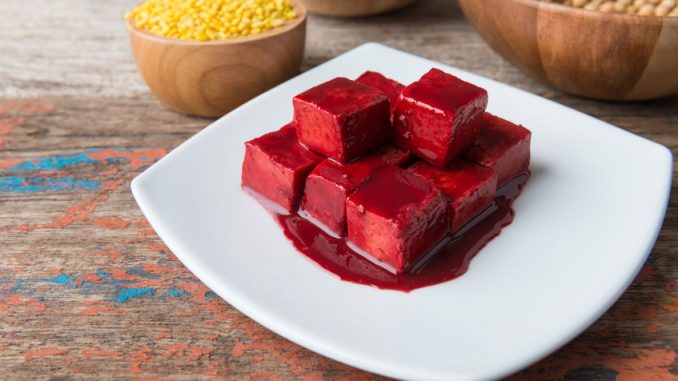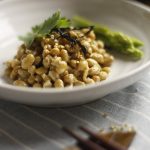
Sufu is an important protein food which the Chinese have been fermenting from soybean curd for centuries. Unlike natto it is prepared as cubes of soybean curd where it is fermented to create a soft, creamy-like cheese product. The process of fermentation is also different having greater similarities to cheese production than anything else (Han et al., 2001).
The food is very popular in China as much for its health properties as anything else. It is easily spread and is often eaten as a side dish. The Chinese like to eat it with steamed bread and breakfast rice.
The first recorded writings about sufu come from the Wei Dynasty which was in existence for a short time between 220 and 265 AD.
The Fermentation Process
The process of fermentation is a classic style of solid-state fermentation of tofu which is soybean curd and then to age it in a 10% brine of salt with alcohol.
Mould fermentation usually begins with various moulds or with a single species which are grown as starter culture suspensions. The tofu is cut into small pieces and inoculated with the spore suspension. The tofu when fermented is known as a maopi or pehtze at this stage. It is kept at constant temperature and a humidity of 90%. Sometimes, there is a pre-fermentation phase. Further mould is added and the fimbria is removed. It is left to cure for 5 days in a 10% brine solution. The whole mass is rinsed and drained. There is a post-fermentation phase of 4 months where it is stored in alcohol such as chinese rice wine.
Types Of Sufu
There are a great many types of sufu depending on the fermentation method. The differences are based on whether the sufu is prepared by natural fermentation, mould or bacteria based fermentation. Sufu also comes in different colours, notably, red, white and grey. This colouring and indeed its flavour depends on the dressing mixture used during the ripening stage. There is a formal classification known as SB/T 10170-2007 “Fermented bean curd”.
Red Sufu or Hong-fang
Thwe dressing mixture is salt, angkak (red kojic rice), sugar and alcohol, flour-koji, past sauce koji and various aroma spices. The external surface turns to red or pale purple whiclts the interior becomes a light yellow to orange. It is the most popular form of sufu because of its vibrant and unusual colour as well as having a strong flavour.
One form of sufu is Chiang fermented bean curd (Chiang-doufu) which is prepared with cubes of tofu soaked in either Chinese-style miso (Chiang) or soy sauce for several days. This form is often reddish-brown in color and salty. It may be dried and fermented further and may also be mixed with sake lees. In Japan, miso is used.
Fermented bean curd is sold in small glass jars.
The fungal starters are Actinomucor, Mucor and Rhizopus spp. The species that have been investigated include Actinomucor elegans, Mucor wutunkiao, and Mucor racemosus. It should not be confused with sticky tofu which is called natto because a type of bacteria is used in the fermentation.
Nutrition
Sufu is extremely high in protein. This can often be broken down by the action of enzymes and bacteria to just volatile, atmospheric nitrogen.
The food is an excellent source of amino acids, calcium, iron and other nutrients. many of the benefits can be ascribed to tofu which is its parent product. Isoflavones are one of the most important compounds to be retained.
Health & Safety Aspects
Unregulated and natural fermentation often produces large amounts of biogenic amines which is a risk factor for this type of food. It has been a cause of concern for sufu producers looking to improve both quality of the product and reduce the health & safety risk. The issues arise during the final curing phase of production.
References
Chou, C. C., Ho, F. M., & Tsai, C. S. (1988). Effects of temperature and relative humidity on the growth of and enzyme production by Actinomucor taiwanensis during sufu pehtze preparation. Appl. Environ. Microb., 54, pp. 688-692
Chou, C. C., & Hwan, C. H. (1994). Effect of ethanol on the hydrolysis of protein and lipid during the ageing on a Chinese fermented soya bean curd-sufu. J. Sci. Food Agr., 66, pp. 393-398
Deng, F. X., Weng, Q. Y., Lu, X. C., & Liu, S. C. (1996). Screening of thermo-tolerant strain of Mucor sp. for sufu production. J. China Brew. Ind., 1, pp. 27-31 (in Chinese).
Han, B. Z., Cao, C. F., Rombouts, F. M., & Nout, M. R. (2004). Microbial changes during the production of Sufu––a Chinese fermented soybean food. Food Control, 15(4), pp. 265-270 (Article).
Han, B.Z., Rombouts, F.M., Nout, M,J. (2001) A Chinese fermented soybean food. Int. J. Food Microb. 65 (1-2) pp. 1-10 (Article)
Li, Y.J. (2006). Modern research on Chinese sufu. China Brewing. 1 pp. 4–7
Yu, R. Q., Tu, Y., & Li, J. W. (2001). Chemical changes in sufu during post-fermentation. J South China Uni. Technol., 5, pp. 64-67 (in Chinese).
Zhang, G. Y., & Shi, Y. G.. (1993). A review of sufu production in China. Food Fermentation Ind., 6, pp. 72-74 (in Chinese).

Leave a Reply